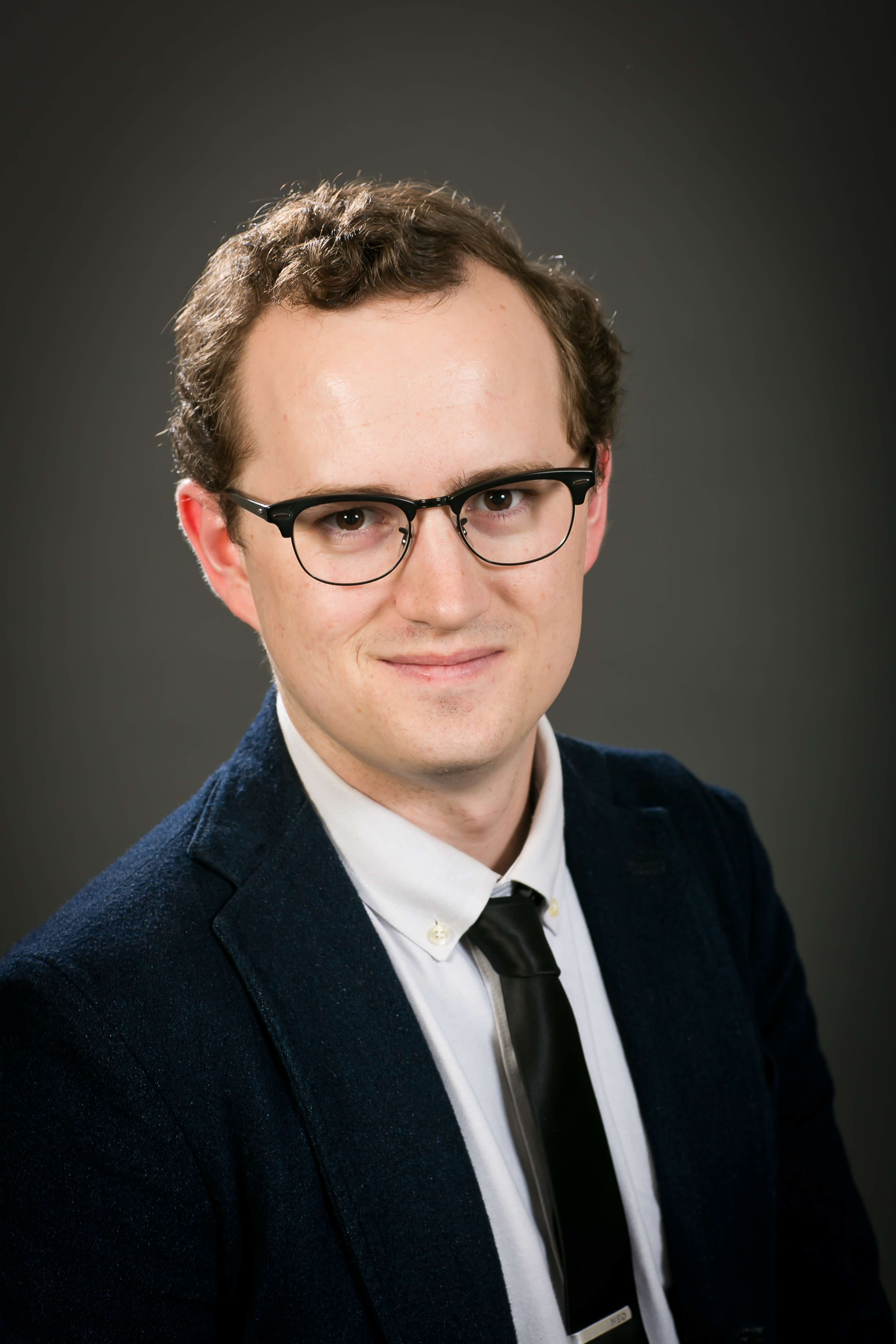Research
My research focuses on spatially resolved star formation and stellar feedback processes in galaxies. I use cosmological zoom-in simulations, and develop analytic theories, in order to understand how local star formation connects to the properties of galactic disks and their environments. I am especially interested in how stellar feedback, in the form of supernovae, drives turbulence in the interstellar medium, and outflows of warm and cold material into the near-circumgalactic medium. I also work to produce synthetic observations from simulations to help differentiate between various star formation theories, validate empirical scalings, and determine the observational consequences of various feedback physics.
FIRE vs. PHANGs: Comparing Simulated and Real Disks
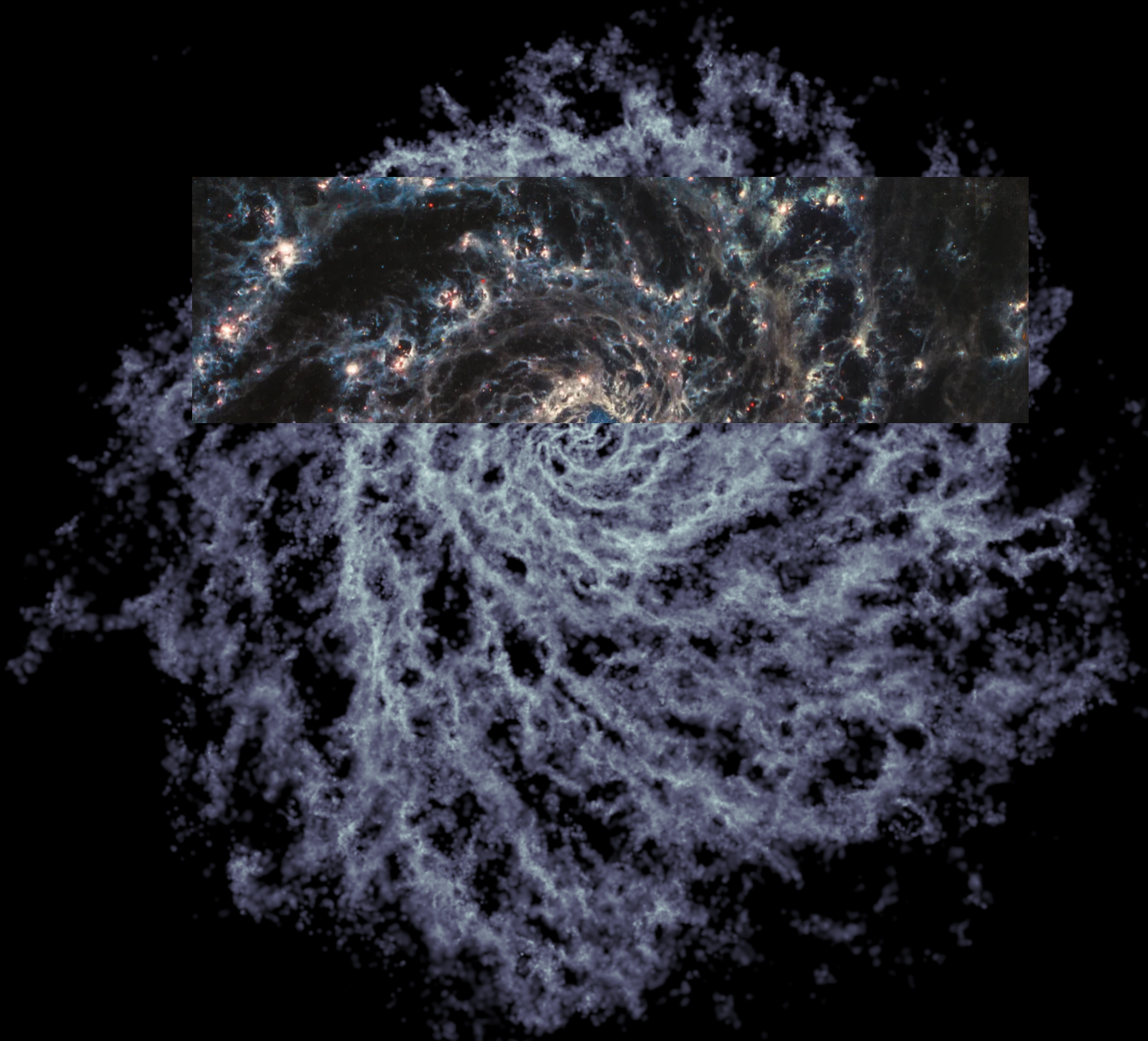
Image: Galaxy simulations have advanced considerably in the last decade. Only in this time have theorists been able to match the gross properties of galaxies, as well as many of the details within them at the sub-kiloparsec level. To highlight this, the image shows the projection of the cold and dense gas structure in the full disk of the FIRE-2 m12i simulation at redshift zero, with an inset image of NGC628 (M74) observed with JWST by the PHANGs team. Remarkable correspondence is seen between the gas structures seen in simulations and the observed galaxy, despite the simulation not having been designed to reproduce this specific galaxy. The ability of our star formation and feedback models to both statistically and visually broadly reproduce the observed galaxy population of star-forming disk galaxies today is a remarkable achievement, and pushes the state-of-the-art to match more subtle relations between gas, dust and stars, as well as the more extreme conditions of the early universe.
Objects May Be Closer than They Appear: Significant Host Galaxy Dispersion Measures of Fast Radio Bursts in Zoom-in Simulations
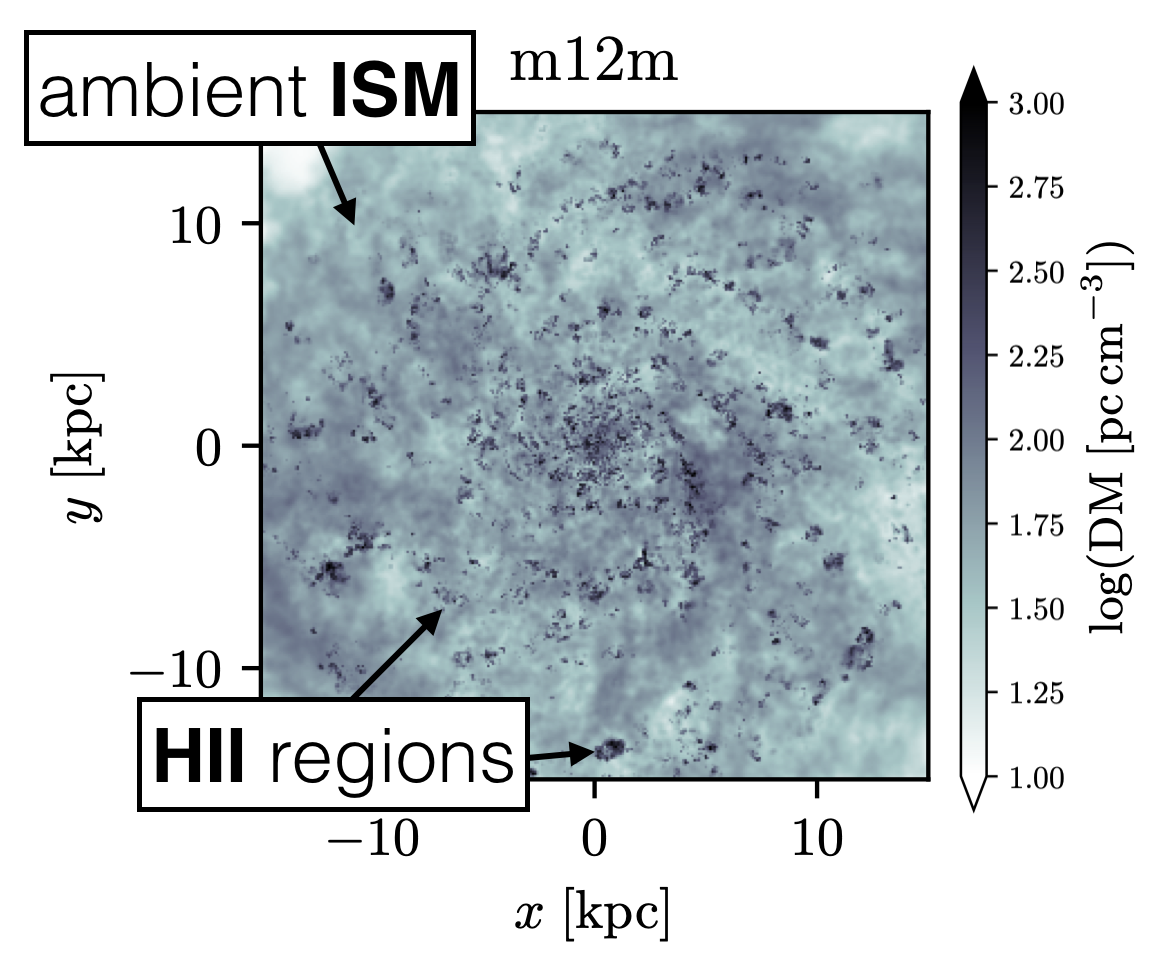
Fast Radio Bursts (FRBs) are mysterious signals from distant galaxies, whose origins remain uncertain. However, as "pings" in the radio sky, they are direct probes of the cumulative line of sight column of free electrons through their dispersion measure (DM) when their signal is received. I modeled the DM to all stars in several FIRE-2 galaxies through cosmic time, to understand the DM distribution and its connection with stellar or ISM properties. I found that the predicted distribution was significantly wider than previously thought from cosmological simulations (without a realistic multiphase ISM), with the normalization shifted to higher values as well. For FRBs without identified host galaxies, this may imply that they are at closer cosmological distances than previously thought.
See the paper here: Orr et al. 2024, ApJL 972:L26
Spiral Arms are Metal Freeways: Azimuthal Gas-Phase Metallicity Variations in Simulated Flocculent Disks
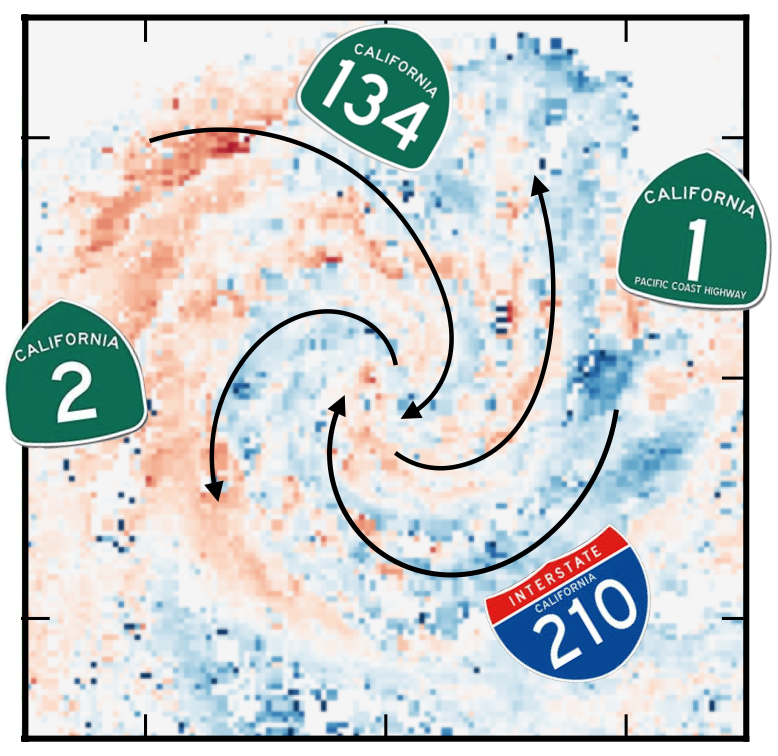
Flocculent spiral arms provide pathways for gas accreting on disks to migrate inwards, bringing fresh gas towards the galactic center to maintain star formation. The arms too provide a route for relatively enriched gas to migrate outwards, mixing metals into the galactic outskirts. In exploring gas-phase azimuthal metallicity variations, I found that the spiral arms in the FIRE-2 disks sustained relatively significant metallicity contrasts (~0.1 dex) compared to the average metallicity at points along their radial extents. The sign of the contrasts depended on whether the arms were locally advecting relatively metal-rich gas outwards (positive), or relatively metal-poor gas inwards (negative). Thus, spiral arms in the FIRE galaxies appear to act as freeways transporting metals in and out of the centers of galaxy disks.
See the paper here: Orr et al. 2023, MNRAS 521, 3708
Bursting Bubbles: The Effects of Clustered Supernova Feedback in Galaxies
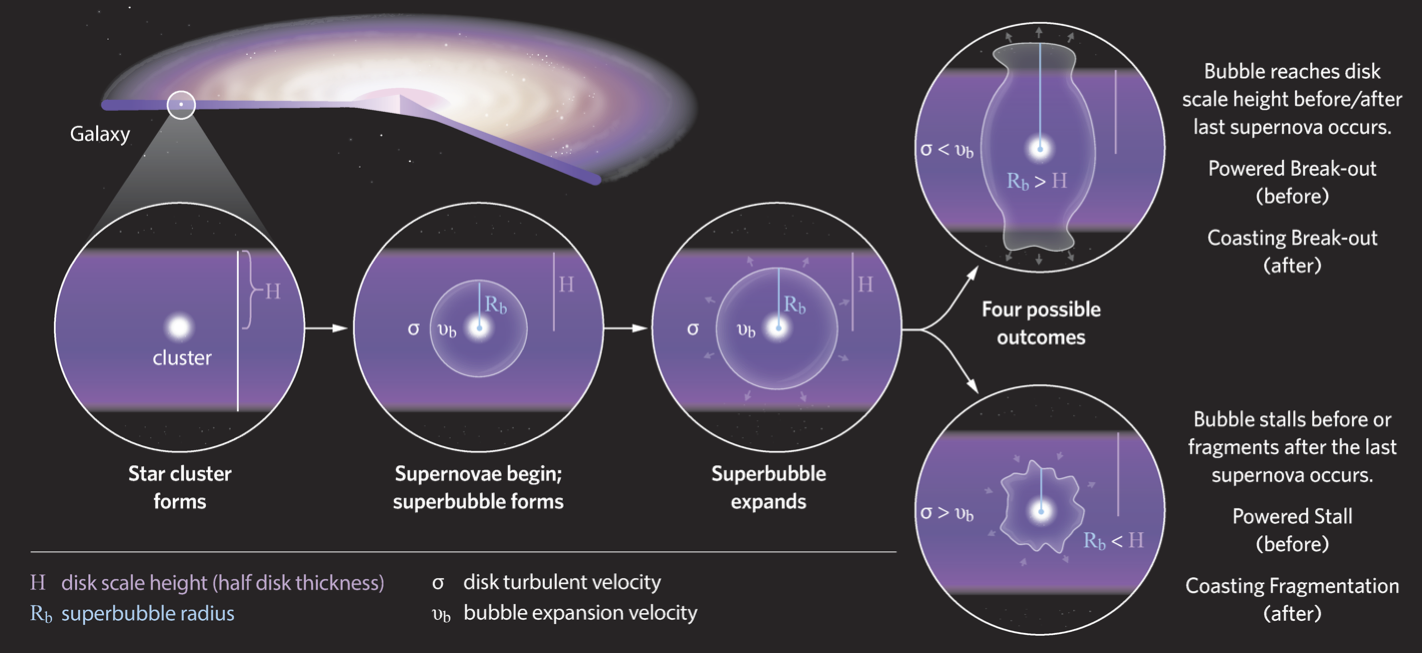
Stars form in clusters within molecular clouds. As a result, stars that form together explode together: the feedback from star formation is also clustered in time and space. In collaboration with Dr. Drummond Fielding whose simulations of star clusters inspired this project, I have built a framework for understanding the effects of clustered feedback on galaxy scale star formation relations, and its implicaitons for disk formation near z ~ 1. We find that the outcomes (breaking out of the galaxy and driving winds/fountains or stalling/fragmenting within the ISM) of superbubbles always occur before the last supernova in a young star cluster detonates. In terms of galactic evolution, it appears that the transition from ubiquitous outflows at high redshift to steady star formation in the local universe is tied to falling gas fractions causing most superbubbles to stall within the ISM rather than successfully break out of the ISM.
See the papers here:
Paper I: Orr et al. 2022, ApJ 932:88 (theory framework)
Paper II: Orr et al. 2022, ApJL 924:L28 (comparing to observations)
Light from the FIRE: CO, CII and H alpha Emission in Cosmological Simulations (Coming soon!)
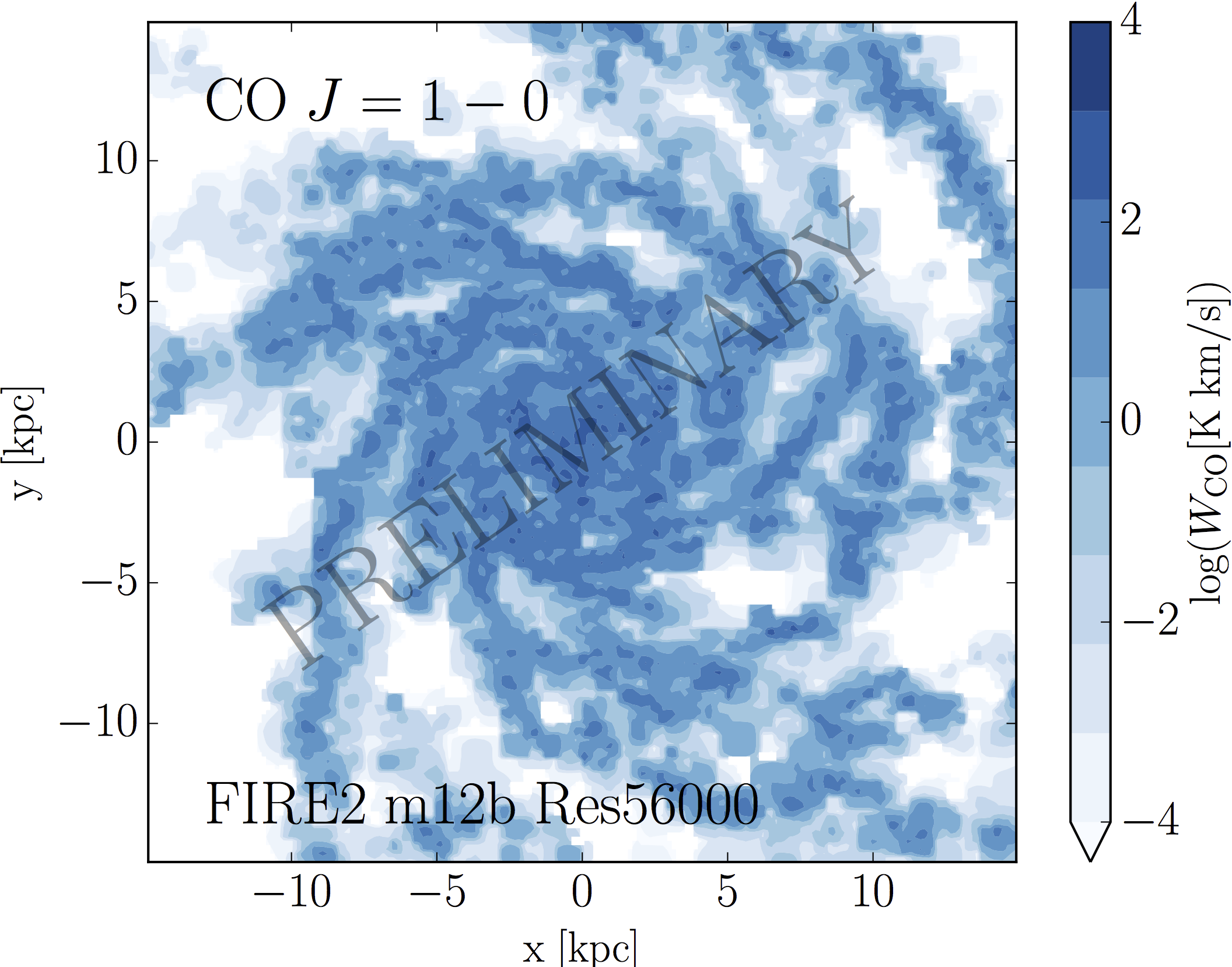
A remaining challenge in connecting simulations with observations lies in how theorists typically report physical quantities taken directly from their simulations, while observers must derive the underlying properties from, e.g., line-widths and luminosities by making a chain of assumptions about molecular and atomic processes, and the dynamical state of the gas. Addressing this, I have developed a pipeline for producing synthetic observations of cosmological zoom-in simulations to directly compare spatially resolved observables predicted by simulations with observations. In the near future, I will be exploring the signatures of star formation, stellar feedback (e.g., cosmic rays, supernovae, etc.), and gas physics models in resolved galaxy scaling relations, probing various observables, like CO or C+ emission, to do so.
Fiery Cores: Bursty Star Formation in Milky Way-analogue Galaxy Centers
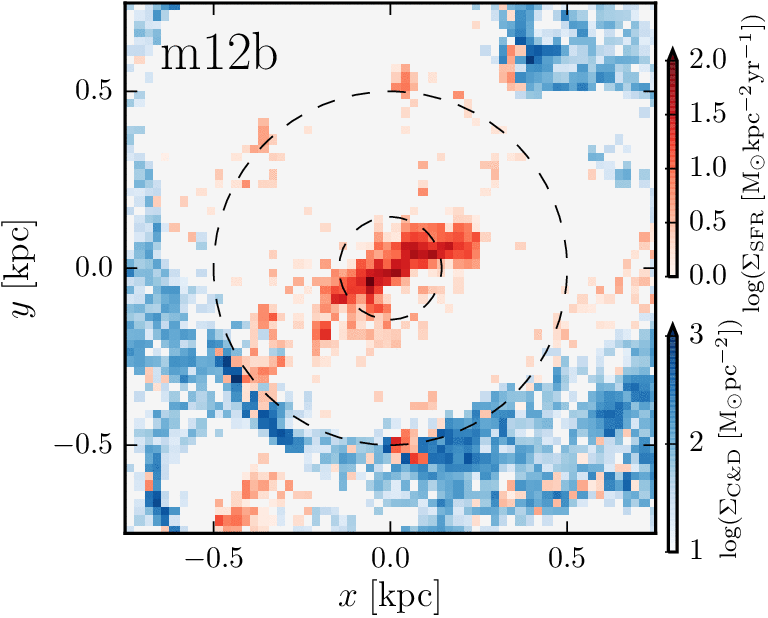
Galactic centers host the most extreme star formation conditions in the Universe, between their high densities and pressures, and intense tidal fields. Much work has gone into understanding how stars form in these environments, notably by looking at our Milky Way's own star-forming center: the Central Molecular Zone (CMZ). In collaboration with Dr. Cara Battersby (her UConn group site) and Ph.D. student H Perry Hatchfield (personal site), I peered into the fiery cores of the FIRE-2 Milky Way analogues to understand how star formation proceeded in their central regions. We found that the galaxy centers fell into two classes: bursty, violent star-forming centers, or fairly quiescent ones with smoothly distributed star formation. The extreme star formation in the bursty cores produced conditions that mimicked the Milky Way, suggesting that our own galaxy center may be in an unstable star formation mode.
See the paper here: Orr et al. 2021, ApJL 908:L31
Swirls of FIRE: Connecting Turbulence and Feedback
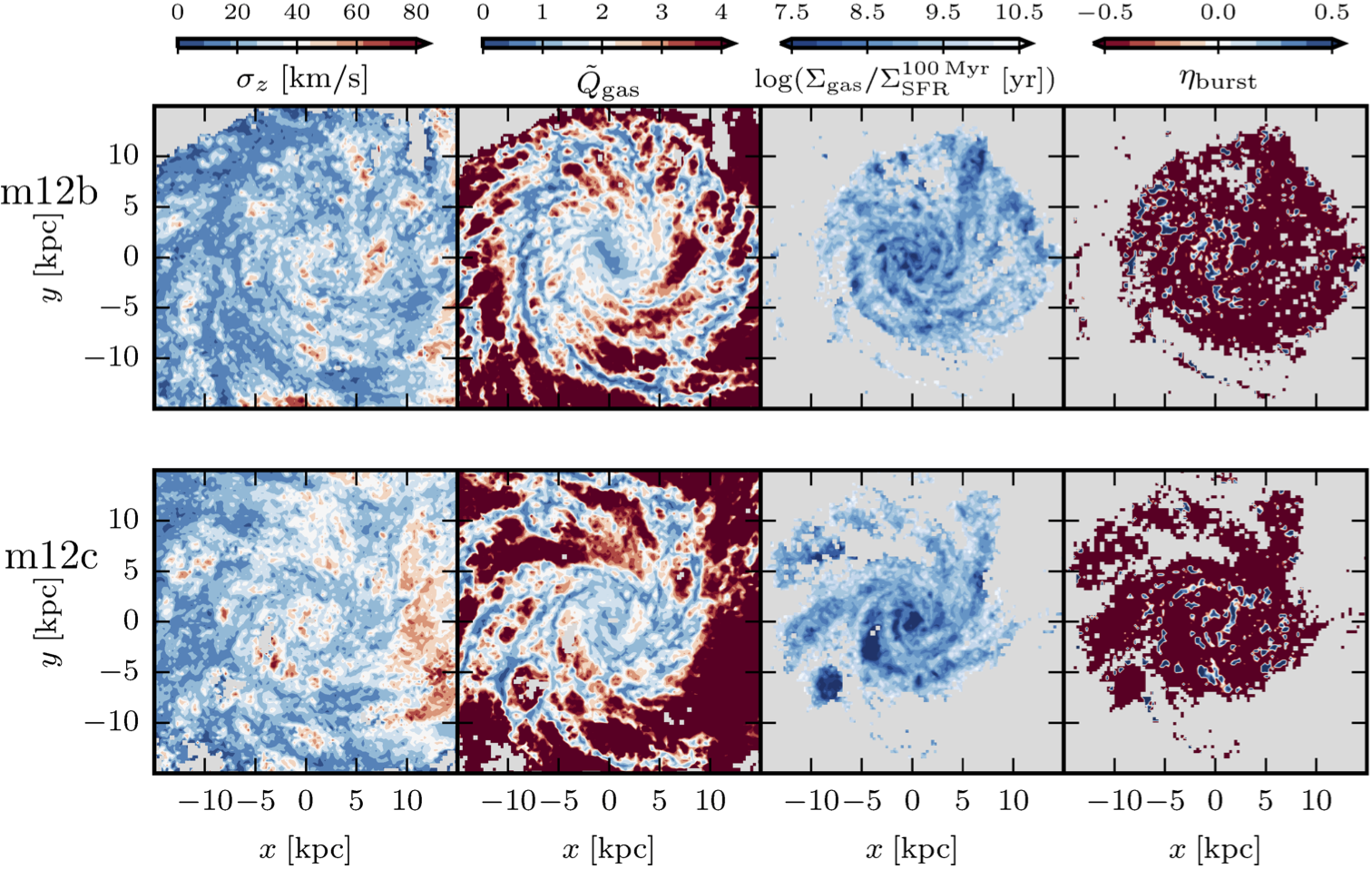
Seeing the awesome power of supernova explosions, there is a natural question of how star formation is connected with the turbulence in the ISM. I studied how gas velocity dispersions and star formation rates relate in FIRE-2 disk galaxies, and was especially interested in the extent to which star formation is able to drive kpc-sized patches of disks away from marginal stability (i.e., Toomre's Q~1). The galaxies are never far from stability, and understanding why this occurs and how quickly local patches can regulate themselves, was a specific focus. I looked into the predictions of Orr et al. 2019 regarding delay times between star formation and (supernova) feedback, finding evidence for `on-off' cycles of star formation in the disks.
See the paper here: Orr et al. 2020, MNRAS 496, 2, 1620-1637
Do Galaxy Disks Breathe?
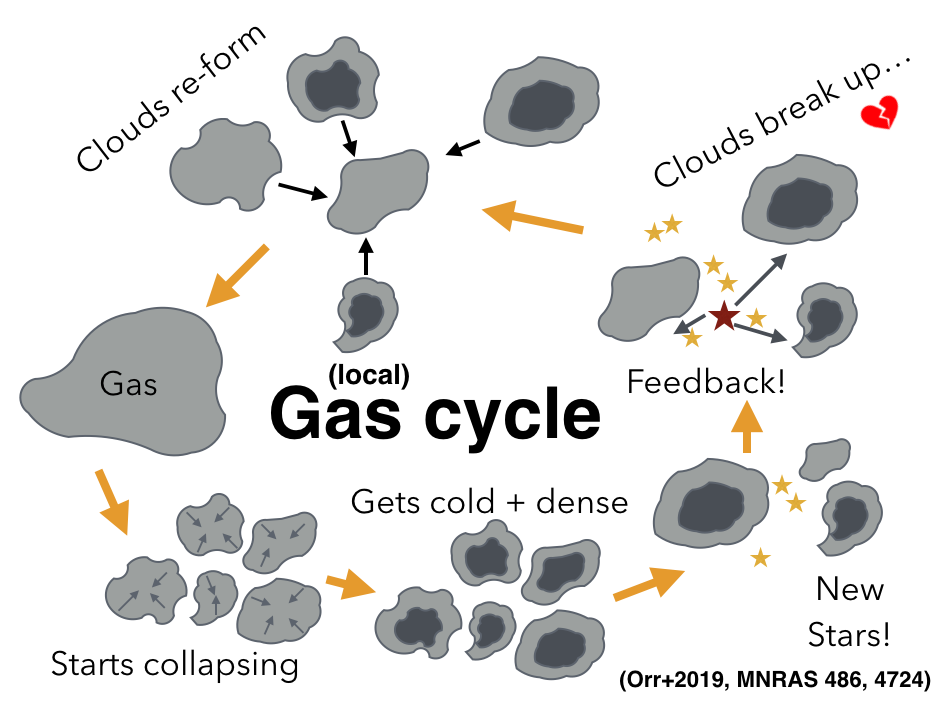
In the feedback-regulated model of star formation, the dissipation of supersonic turbulence (the primary support of cold and dense gas in galaxy disks) is balanced by the injection of stellar feedback momentum from ionizing radiation and supernovae. This is generally thought of as being in a "static equilibrium". However, the injection of supernova feedback is inherently bursty, time-dependent, and lags relative to star formation itself. As a result, galaxy disks may be expected to "breathe" to some extent. How much do typical disk galaxies breathe? I developed a simple analytic model to understand how star formation can drive itself to ~dex variations on 10 Myr timescales.
Dark Background Gas Cycle Cartoon
See the paper here: Orr et al. 2019, MNRAS 486, 4, 4724-4737
What FIREs Up Star formation? Kennicutt-Schmidt on FIRE
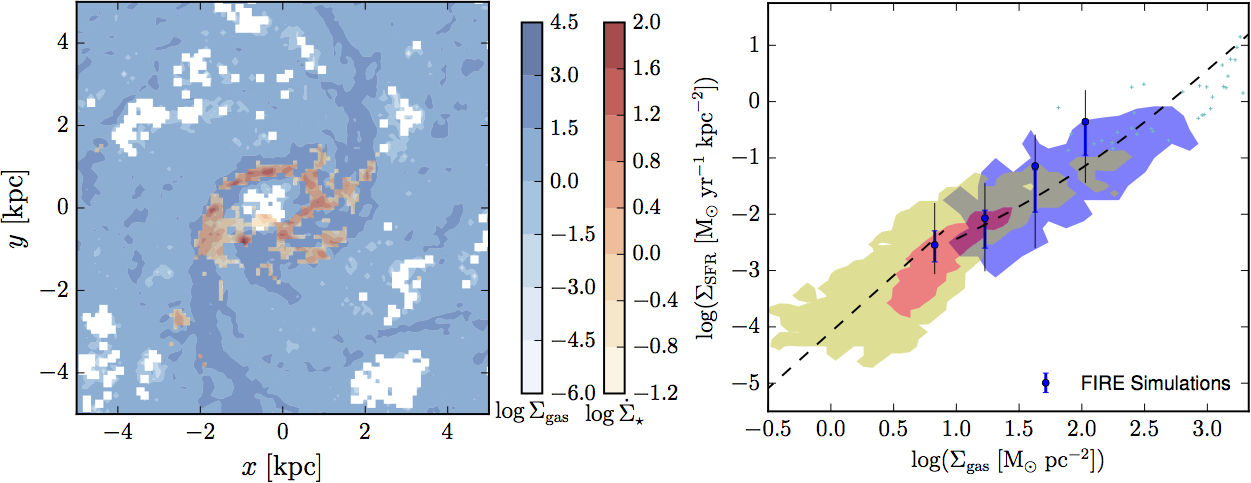
Cosmological simulations have given us a unique ability to understand how scaling relations in star formation emerge on kpc-scales in galaxies. I investigated the Kennicutt-Schmidt relation in the FIRE simulations- specifically, looking at how and at what spatial and temporal scales the relation breaks down, and its dependencies on redshift, metallicity, and gas surface density and star formation rate tracers. As well, I looked at what sets the extent of the star-forming disks in our galaxy simulations, finding that they were circumscribed by the limits of gravitational fragmentation in hot, ionized gas.
See the paper here: Orr et al. 2018, MNRAS 478, 3, 3653-3673
Stacking is Hacking
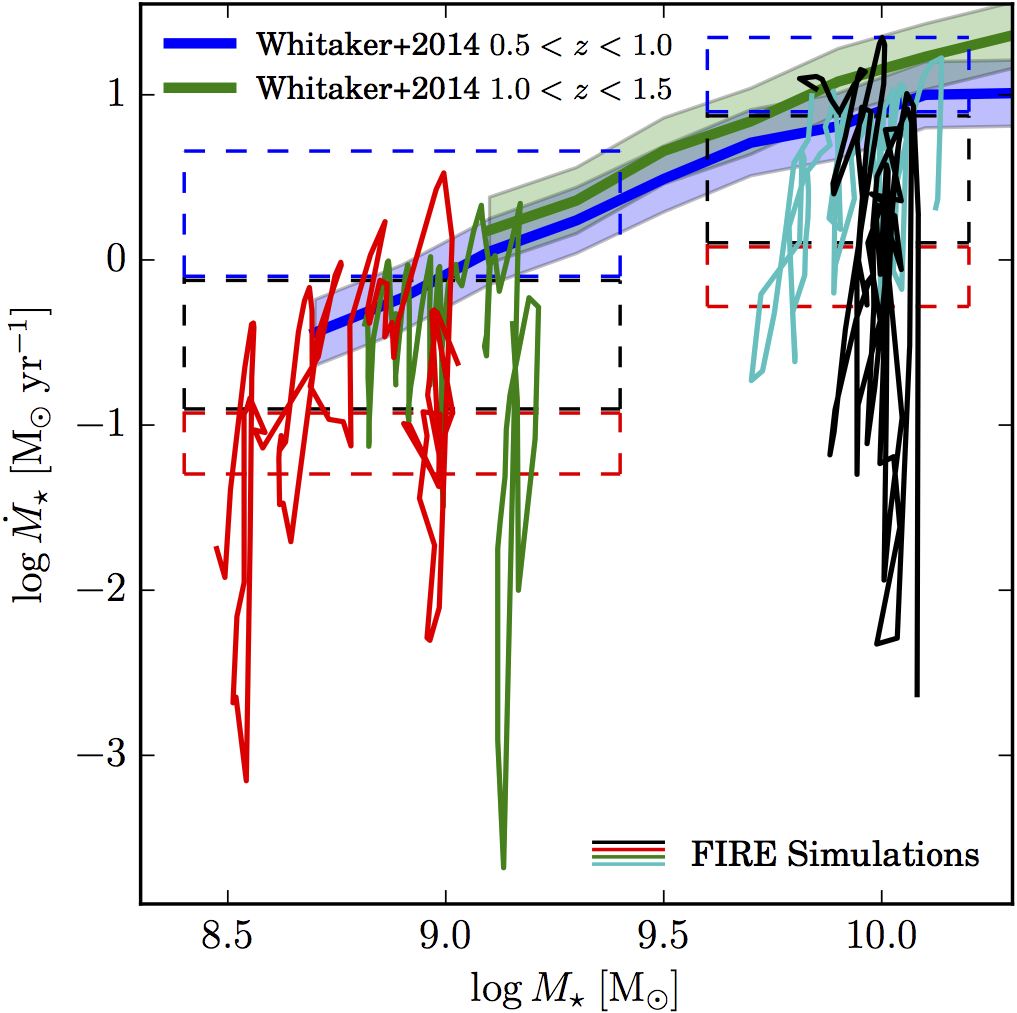
High-redshift observations of galaxies are difficult, and have low signal-to-noise. And so, observers often stack many spatially-resolved observations of similar galaxies to get a result. How does stacking affect inferred average star formation rate profiles? Turns out, quite a bit. High-redshift galaxies are very bursty in their star formation, and as a result stacking can bias our inferences of how those galaxies and their star formation rate profiles evolve.
See the letter here: Orr et al. 2017, ApJL 849:L2
